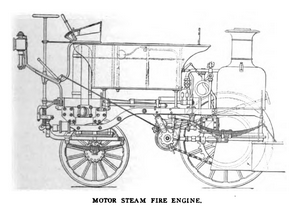

















|
|---|
|
MOTOR STEAM FIRE ENGINE. Publication: The Hub Date: August 1901 Subject: Emergency Services Vehicles |

|
THE steam fire engine belonging to the Norwich Union Fire Insurance Company, and stationed at Worcester, has been recently converted from a horse-drawn engine into a self-propeller by Mr. Chas. T. Crowden, of Leamington. The conversion was effected while the engine was kept in service, and it attended several fires while the work was in progress. The original road wheels were far too light for motor purpose, and a new set of wheels was constructed under Mr. Crowden’s patents, by which the spokes are set back at the hub, thereby ensuring safety against the great lateral strains to which motor wheels are subjected. The hind or driving wheels are fitted with star wheels and sprockets. A motion frame for carrying the crank shaft. Differential shaft and gearing was hung to the main frame, in front of the brake shaft by two special brackets and fixed by two bolts, these bolt holes being practically the only fresh holes made in the existing frame. The motion frame is attached to and can be removed from these brackets when required. Each end of the differential shaft is fitted with a sprocket pinion and connected up to the hind wheels by means of a pitch driving chain, which is adjusted by two setting up radial stays. To this frame is attached a double cylinder engine fitted with link motion, driving the double throw crank shaft, to one end of which is fitted a pinion driving the differential gear shaft to the ratio of 5.1 to 1. Steam is taken to the propelling engine from the main steam pipe feeding the fire engine, and the exhaust is taken into the existing fire engine exhaust pipe; these pipes were made in such a form as to allow for a certain amount of spring when adjustments were made to the chains as the engine and motion frame move forward. The old hose box was removed and a water tank substituted having a seat and footboard for three men to sit abreast, and a fireman sitting on the top of the water tank with footboards as before. The center man or driver has full control and manipulation of the engine from his seat. An extra screw brake is provided as an emergency brake; it can be operated from behind by the stoker, the coal bunkers have been altered to give a larger capacity, and a seat is fitted for the stoker for firing en route. The boiler is provided with a detachable ashpan for preventing the hot cinders falling upon the road. The original forecarriage is used, achannel steel sector being fitted to the splinter bar by two stanchions, and a chain pinion attached to the vertical shaft gearing into a length of pitch chain fixed in the channel to serve the purpose of a rack. Should the motor part of the engine become disabled the motor enine and gearing can be easily removed by withdrawing a few bolts, and the engine used as a horse-drawn engine. The boiler, when the motor engines were used, was originally fed by an injector which was not altogether satisfactory, and a feed pump is now being attached, worked from the countershaft, also a special apparatus for filling the water tank from the river or roadside streams and other sources. The motor engine has proved itself very satisfactory up to the present, and will run on the level road at a speed of about twelve miles an hour, and will climb all the hills that have been met with up to the Present, some grades of which in this district are very severe. It is stated that a very great saving will be effected by its use in Worcester, the horsing of the engine previously costing a guinea a mile, and the work being so severe that no one cared about lending their horses for the fine engine, which weighed about three tons when loaded with all its appliances and firemen. Often thirty to fifty minutes have been wasted in getting horses, which, when an alarm of fire was given, were at work at their daily duties. A considerable amount of time was also lost in finding the proper harness for them; the horsing of steam fire engines in country districts is a very difficult question. The motor after lighting the fire can be got away in about five minutes under its own steam. The speed of the motor is about twelve to fourteen miles an hour.—The Engineer.
